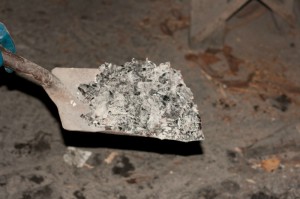A roaring fire can be a welcome sight during the cold months of winter. To keep their fireplaces running properly, homeowners know to have their chimneys swept and inspected each year. However, few pay much attention to what they do with the byproducts of their wood burning fires – the ashes.
Regular ash disposal can improve the efficiency of your fireplace, and properly disposing of ashes can prevent accidental fires. Rather than seeing the measures needed to properly remove ashes as an inconvenience, homeowners should instead see it as taking steps to ensure their family’s safety.
How can ashes be dangerous?
While ashes themselves pose little to no threat to you or your family’s safety, it’s what they can keep hidden that are the real danger. Small coals and embers can lay dormant when surrounded by ash, only to ignite later on. According to forestry officials, “Wood ashes retain enough heat to ignite other combustible materials for several days.” Because of this, all ashes should be treated with caution, especially those from recently extinguished fires.
Improper ash removal methods
Unfortunately, many of the most common methods of ash removal are also the most unsafe. Ashes should never be mixed with garbage or trash; this even includes putting cold ashes into regular trash cans or dumpsters. Likewise, ashes should never be transported in cardboard boxes, paper bags, or other combustible containers. Lastly, vacuums should not be used to clean up ashes unless they have a HEPA filter. Without an appropriate filter to prevent dust particles from becoming airborne, even shop vacuums may leave carpets, walls, and other furnishings coated with a fine layer of dust.
Proper ash removal
The first and most important step in ash removal is ensuring that there are no remaining hot coals or embers in the ashes. This can often be achieved by letting a fire extinguish naturally overnight and stirring the ashes the next morning to ensure there are no remaining hot spots or pockets of heat. Ashes can then be transferred into a specially designed metal ash container that has a tight fitting lid. Ash containers should never be stored indoors, in garages or sheds, or near combustible materials in case there any remaining coals or embers.
Alternative uses of ashes
After using your wood burning fireplace all winter long, you may find yourself with a surplus of ashes. Luckily, there are several alternative ways that ashes can be used around the home. Two of the most popular uses for ashes are in the garden: as a fertilizer or as a bug repellant.
As a fertilizer, small amounts of ash can be used on garden plots or in compost piles. Ash “improves root health and strengthens the very cellular structure of plants, helping them resist all kinds of stresses,” says Julia Gaskin. Likewise, when sprinkled around the edges of a garden plot or flower bed ashes can serve as a natural repellent for slugs and snails.
Lastly, ashes can be sprinkled on icy driveways or sidewalks as an alternative to salt or gravel to prevent slipping. However, homeowners and their guests should take special care to wipe the soles of their shoes off after walking on an ashy path. If not, you may accidentally track dirty footprints throughout the house!
Properly removing and disposing of ashes can protect your family against accidental accidents or fires, and ashes can also have a surprising number of uses around the home. If you have questions about ash disposal or how to help your wood burning fireplace burn more efficiently, contact Lord’s Chimney today!


